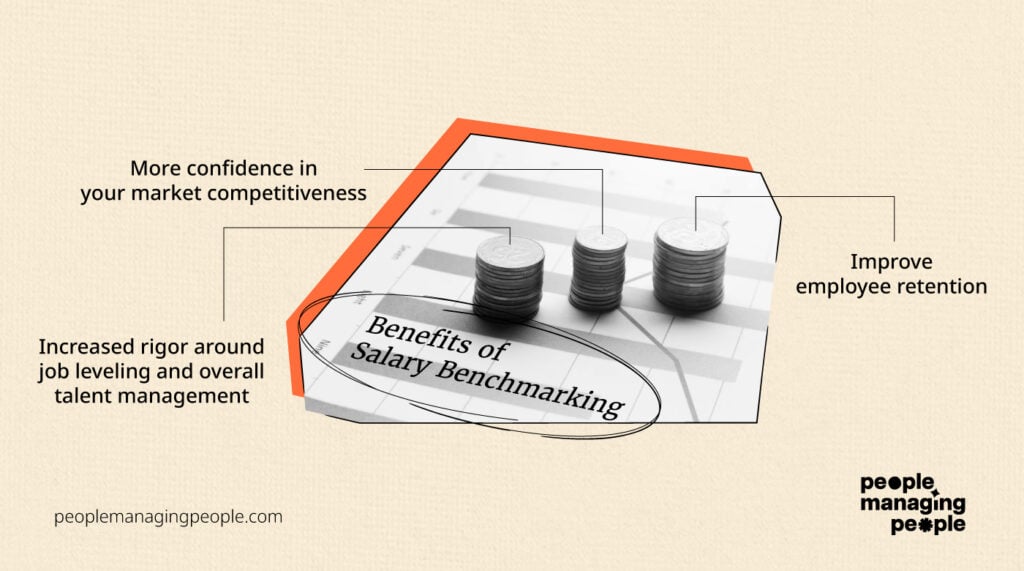Any employee who can achieve a raise of 10% or higher by switching jobs will likely do so. This might come off as disloyal on the part of the employee, but I would challenge employers to ask what steps they’re taking to prevent this kind of attrition from their top talent.
Are you leveraging and developing your talent efficiently? Are your benefits competitive and have you conducted compensation benchmarking or salary surveys to ensure that your compensation is competitive?
There was an observable trend during and in the wake of COVID where the job market experienced a paradigm shift in favor of employees.
This had employers scrambling to make sure they were doing everything they could to attract and retain talent; including the increase in hybrid and work-from-home arrangements and ensuring their compensation is competitive.
If salary benchmarking is not something your company is doing regularly, or has never done at all, then now is the time for you to do it.
Throughout my career, I’ve run salary benchmarking projects both internally and as a consultant for other organizations.
Here I’ll take you through why salary benchmarking is an exercise that’s very much worth your time as well as how to do it.
- What is salary benchmarking?
- What are the benefits of salary benchmarking?
- How to benchmark your salaries against the market
As you’ll see, it's something any HR professional should be able to complete.
What is salary benchmarking?
Salary benchmarking is a process where you compare your job descriptions and compensation to similar positions in companies of a similar size and industry in order to see how competitive your compensation is compared to peers.
By conducting an analysis of this nature, you can ensure that your compensation is competitive and aligns with your organization's compensation philosophy.
What are the benefits of salary benchmarking?

Salary benchmarking is very much a worthwhile endeavor, though it can come at a cost (more on that later).
More confidence in your market competitiveness
The first and major benefit of conducting salary benchmarking is that helps you be confident that you’re paying employees competitively in line with your compensation philosophy. Even if your compensation strategy is wanting to pay at benchmark, you can get reassurance that your average salary is in line with market data.
You want to make sure you are abiding by the philosophy you have in place, and, without a project like this, it can be difficult to tell if you’re truly walking your talk, as the expression goes.
Improve employee retention
The upshot of being competitive in the market is that your workforce will feel fairly compensated and it will be more difficult for rival organizations to poach them.
Of course, compensation isn’t the be-all and end-all, but it’s certainly a key factor in employee retention.
An added bonus here is that employees who are not concerned about their compensation being competitive will be more productive and have a higher degree of employee engagement.
Increased rigor around job leveling and overall talent management
The last benefit of salary benchmarking is that it forces you as an organization to regularly reevaluate your compensation philosophy, the jobs themselves, career paths, and can aid in the creation of salary ranges, grades, and job levels—an exercise that can certainly be neglected in the more traditional set-it-and-forget mindset when it comes to building positions in your organization.
By engaging in salary benchmarking projects regularly, it ensures you’re plugged into any major market shifts in compensation which could cause your employees to look around.
It's important to keep pace with market rates or you may risk losing top performers whose compensation is at the level where yours should be.
This kind of proactive compensation management is exactly what you need to make sure you are staying competitive and playing an active role in your talent management process.
How to benchmark your salaries against the market
Once you’ve made the decision to conduct salary benchmarking, it's important to know the steps involved to be sure you’re completing a full analysis.
1. Determine which positions to benchmark
The first step is determining which positions you want to perform the analysis on. A broad approach would be one where you gather benchmarking data on all of your positions, but this can be a large undertaking depending on the size of your organization.
Instead, you might opt to pick a few jobs where there is a high degree of attrition or competition in the market to determine proper pay ranges for those roles to ensure your job postings are competitive.
If you keep losing workers from a specific job or job family, or you’re having a hard time hiring for a particular job, those are key candidates for salary benchmarking.
2. Refine your job descriptions
After you’ve selected the jobs you want to gather benchmarking data on, your next step is to refine your internal job descriptions.
Now this doesn’t necessarily mean completely reworking them, but reviewing them and making sure they’re accurate to what the people in those roles are doing on a daily basis. Many jobs evolve over time, but typically the job descriptions for those roles are not updated as regularly as they should be.
This is an important step because job descriptions are how you are going to compare your jobs to similar jobs in the market data set you use. There are many different job titles for what can be the same job—think of how many different iterations of a job title like customer service specialist exist!
This is why the more important thing to look for is the duties of the jobs in question to ensure you’re getting the best match and most accurate data.
3. Select your data source(s)
The next step is selecting a relevant salary data source for your salary benchmarking.
It's important to select salary data that is relevant to your industry and can provide the best information to complete the analysis.
Some of these sources are free to use, with some limitations and drawbacks, and some are paid (the paid datasets tend to be more robust).
Deciding which source to use can be difficult, and cost is surely a factor, but completing compensation benchmarking with a free salary data set is still better than not doing it at all.
TechRepublic has put together a guide on some of the best providers of compensation data, along with their various pros and cons, which you can use to help determine what would best suit your needs.
On a personal level, I’ve found a lot of success using the data from the Bureau of Labor Statistics (BLS), which is a free source.
The data from the BLS casts a pretty wide net and doesn’t allow you to filter down to industry, size, or profitability, but I often argued in favor of these conditions.
If you’re hiring for an accountant, you want to be sure your compensation is competitive regardless of the company size or industry; jobs like this are not limited to a single type of company, so ensuring competitive compensation against a larger range of peers is advantageous.
4. Compare the data against your own compensation level
Finally, once you have pulled the data you can then compare the data from the source against your own compensation level.
Often these sources will show you compensation at different percentiles for a given role in order to show you what the average is at the 50% tier, and what is above or below the benchmark at the 75% and 25% tiers respectively.
What’s nice about this is that you can also use the percentiles as a guideline for creating salary grades.
You may start a new hire slightly below the 50% point and have senior incumbents closer to the 75% mark. This phase of the project is where your compensation philosophy will come into place; are you comfortable being right at benchmark in the 50% range, or do you have a more aggressive compensation philosophy and want to be above benchmark?
This is the question you should have ready to answer when you’re getting ready to wrap this process up and make decisions.
Salary Benchmarking Case Study: A Fully Remote Organization
As mentioned, I’ve helped conduct analyses like these for a number of clients over the years in my role as a human resources consultant and when working internally.
The best case scenario is that it reassures them they are competitive, and the worst case is they realize they have fallen behind and need to make adjustments to align with the market and their compensation philosophy.
However, the consistent theme for all of them is wanting to be proactive about their compensation before it costs them talent.
It’s well known that replacing an employee is significantly more expensive than retaining that employee, which makes the case that it's actually more cost-effective to make market adjustments to competitive salaries than it is to have to replace employees you have lost due to paying rates below market standard.
One previous client I worked with had an entirely remote workforce and they wanted to be sure their compensation was competitive regardless of the geographic location of their employees.
This was an interesting challenge because, even within the same job, the compensation range can vary significantly when you compare a state with a higher cost of living, like New York, to a state with a lower cost of living like Iowa.
Normally the geographic location of the organization itself is a filter for the data to make sure your compensation is in benchmark within their specific geographic region.
The result of this was that, for every position we reviewed for the organization, we pulled data from the highest cost of living state in the dataset to ensure that the range they landed on would always be at or above the benchmark.
Other clients I’ve had wanted much more narrow data, down to even a particular city or county, and were satisfied with being at or slightly below the benchmark.
Something I made sure all of my clients had in common for these projects was first having a solid compensation philosophy that we could use as the foundation for their compensation benchmarking project.
Next Steps
At this point, you should have all the tools you need to get your benchmarking project going, but let’s remember some of the important points we discussed.
First and foremost you want to make sure we are solid on your company's compensation philosophy so you can apply it to this project.
You also want to make sure all of the job descriptions you’re going to be using have been reviewed and updated as these are going to be the most important pieces of data for you to match to other jobs.
Picking the right data set is an important decision, but one where you have options in terms of price and how thorough or specific the data is.
You can also use the same data to evaluate or create salary grades when you’re getting ready to make any market adjustments to salaries.
The most important point to leave you with is that, even if you’re only benchmarking one position with free data, it’s still an investment that is very much worth your time and effort!
Even insights gained with free data will provide you with more reassurance on the competitiveness of your compensation than doing nothing. For the small investment of some time to complete this analysis with free data, you will be able to avoid any unnecessary turnover due to your compensation being less competitive than you might think.
Many organizations use compensation management software to help them with tasks such as benchmarking, undertaking pay equity audits, and aligning pay with performance.


